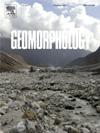沙洲-泻湖海岸真实新生植被诱发的跨岸剖面演变:实验室实验
IF 3.1
2区 地球科学
Q2 GEOGRAPHY, PHYSICAL
引用次数: 0
摘要
近年来,人为活动和气候变化对泻湖生态系统造成的压力迅速增加。海岸植被是一种天然的海防机制,在维持稳健的生态平衡方面起着举足轻重的作用。然而,我们对植被如何影响典型沙洲-泻湖海岸演变的了解十分有限。为了填补这一空白,我们在典型的沙洲-泻湖断面上进行了一系列移动水槽实验,研究在不同水深和不规则波浪条件下,沙洲上种植的稀疏葭藻对波浪传播和跨岸剖面演变的影响。这些研究结果表明,植被可减弱次重力波和海涌波。值得注意的是,次重力波与直角或钝角前沙丘疤痕的形成有关,而海涌波则倾向于形成锐角疤痕。植被引起的波群内短波局部振幅的变化和局部平均水位的变化有助于重塑前沙丘疤痕。此外,与固体体积分数相比,植被的跨岸宽度对泻湖内沉积物迁移的影响更为明显。稀疏的植被不仅能减少泻湖内的沉积物沉积,还能增强离岸沉积物的迁移。这些见解极大地推动了我们对波浪-植被-沉积物动力学的理解,为实施海岸生态恢复计划,尤其是沙洲-泻湖海岸的生态恢复计划提供了重要的科学支持。本文章由计算机程序翻译,如有差异,请以英文原文为准。

Cross-shore profile evolution induced by real emergent vegetation in a sandbar-lagoon coast: Laboratory experiments
Pressures from anthropogenic activities and climate change in lagoon ecosystems have increased rapidly in recent years. Coastal vegetation serves as a natural sea defense mechanism and is pivotal in maintaining a robust ecological balance. However, our understanding of how vegetation influences the evolution of typical sandbar-lagoon coasts is limited. To address this gap, a series of mobile-bed flume experiments were conducted within a typical sandbar-lagoon cross-section to investigate the impact of sparse Phragmites spp. planted on the sandbar on wave propagation and the evolution of the cross-shore profile under varying water depths and irregular wave conditions. These findings revealed that vegetation attenuates infragravity and sea-swell waves. Notably, infragravity waves are associated with the formation of a right- or obtuse-angled foredune scarp, whereas sea-swell waves tend to create an acute-angled scarp. Vegetation-induced changes in the local amplitudes of short waves within wave groups and the local mean water level are instrumental in reshaping foredune scarps. Additionally, the cross-shore width of the vegetation had a more pronounced influence on sediment transport within the lagoon than that of the solid volume fraction. Sparse vegetation not only reduces sediment deposition in the lagoon but also enhances offshore sediment transport. These insights significantly advance our understanding of wave-vegetation-sediment dynamics and provide essential scientific support for the implementation of coastal ecological restoration initiatives, particularly in the context of sandbar-lagoon coasts.
求助全文
通过发布文献求助,成功后即可免费获取论文全文。
去求助
来源期刊

Geomorphology
地学-地球科学综合
CiteScore
8.00
自引率
10.30%
发文量
309
审稿时长
3.4 months
期刊介绍:
Our journal''s scope includes geomorphic themes of: tectonics and regional structure; glacial processes and landforms; fluvial sequences, Quaternary environmental change and dating; fluvial processes and landforms; mass movement, slopes and periglacial processes; hillslopes and soil erosion; weathering, karst and soils; aeolian processes and landforms, coastal dunes and arid environments; coastal and marine processes, estuaries and lakes; modelling, theoretical and quantitative geomorphology; DEM, GIS and remote sensing methods and applications; hazards, applied and planetary geomorphology; and volcanics.
 求助内容:
求助内容: 应助结果提醒方式:
应助结果提醒方式:


